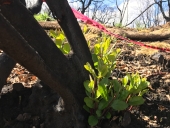
 3
3





![Filename: Screen-Shot-2018-11-30-at-3.59.10-PM.png
Description: The Western Slope, approx. 25-30 acres [Thumbnail for Screen-Shot-2018-11-30-at-3.59.10-PM.png]](/t/98351/a/69083/Screen-Shot-2018-11-30-at-3.59.10-PM.png)
![Filename: Screen-Shot-2018-11-30-at-4.00.51-PM.png
Description: The Western SLope, approx. 25-30 acres [Thumbnail for Screen-Shot-2018-11-30-at-4.00.51-PM.png]](/t/98351/a/69084/Screen-Shot-2018-11-30-at-4.00.51-PM.png)
 1
1




 2
2




Miles Flansburg wrote:Thanks Perric !
We took a drive through some of that area about a year after the fire. Just devastating. At the time I wondered if someone might go in and cut the standing burned wood and lay them across the slope to try and stop erosion but it looks as though most of the area has just been left to nature . I am glad to see that she is beginning to grow at least a carpet of grasses.
Will you have any help from the conservation district or forest service as far as getting young trees to reforest?
Will you be seeding any areas with different plants, shrubs or trees?
Are you seeing any mushrooms at work?
Will you be keeping it in a native state or will you introduce any fruits like hazels or serviceberries etc.?
Can you use the brook water or build dams of any kind to slow the water and spread it?
Sorry for all of the questions but I think this will be a great project !!
 1
1








Kani Seifert wrote:Hello Perric!
Have you been over to and/or seen information about CRMPI in Basalt, CO? They are on a mountain side and have a mature food forest planted there. They might be able to provide information about planting techniques and plants that will do well on your property.
About the native vs. non-native plant controversy--most plants migrate to where they function best and so, determining what is actually "native" depends on the when, not necessarily the where. What your goals are for the property should help determine what you are to plant. If you want food and a somewhat sustainable future, then the trees, shrubs, and perennials that can grow in your altitude/temp/moisture area would be the most relevant for you. If you are just trying to restore the original flora, then "natives" are the way to go. Personally, I use a mixture of both--trying to find the natives that produce food in my Zone 4. However, I'm prone to try some non-natives for their productivity and taste!
Best wishes to you on your adventure. If you are ever headed to Wyoming, send me a message!
- Kani
 1
1




 1
1




 2
2




 1
1




 2
2




 1
1




 1
1





|
This looks like a job for .... legal tender! It says so right in this tiny ad:
The new purple deck of permaculture playing cards
https://www.kickstarter.com/projects/paulwheaton/garden-cards
|







